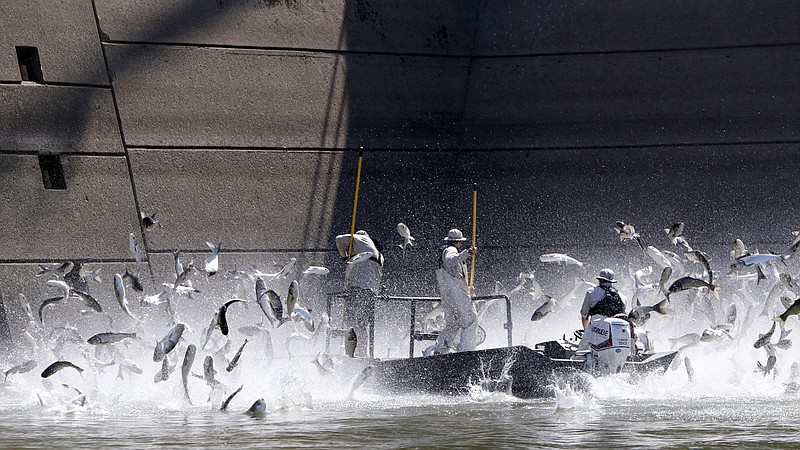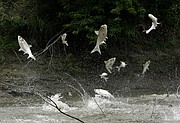Seven dams on the Tennessee River should have barriers installed to mitigate invasive Asian carp that pose problems for native fish and can even injure boaters, according to a final environmental assessment from the Tennessee Valley Authority last week.
"Fish barriers in Kentucky, Wilson and Pickwick locks should be immediately installed followed by installation in Guntersville, Nickajack, Chickamauga and Watts Bar locks," a news release on the assessment states.
While TVA is not the lead agency for controlling the spread of Asian carp in the Tennessee River, the federal utility conducted the assessment to support a national, multi-agency effort including the Tennessee Wildlife Resources Agency, U.S. Fish and Wildlife Service and 28 other agencies with fisheries management jurisdiction to control Asian carp in the river system, TVA officials said in the release.
Currently, Kentucky and Wilson dams are set to have the first barriers installed once funding is secured, and the remaining installation schedule will be determined as funding is received, according to TVA. Congressional funding is required to install the barriers because the effort involves multiple states.
Photo Gallery
Study recommends curtains of unpleasant bubbles to fence Asian carp in Tennessee waters
The barriers will be a combination of bio-acoustic fish fences and carbon dioxide emitters designed to keep Asian carp from entering a dam's lock chamber with a curtain of unpleasant bubbles. When the lock opens, the barrier emits sound, light and bubbles to steer Asian carp away from the lock. Tests conducted by the U.S. Fish and Wildlife Service and other agencies at Barkley Dam in Kentucky indicate barriers deter upstream movement of the fish as boats lock through the dam.
Construction of the fence at Barkley Lake began in July 2019 and preliminary data from the field trial "has shown the barrier to be approximately 98% effective at keeping all sizes of Asian carp from passing into the lock," the assessment states. An image of a silver carp was reportedly taken in Chickamauga Lake in 2019, but state officials said the fish weren't reproducing yet.
The barrier plan has an opponent in Watts Bar Ecology and Fisheries Council chairperson Tim Joseph, a fisheries biology expert who says the state's plan is backward and speculative. The first barrier should be installed at Watts Bar's lock to protect the yet-uncontaminated upstream waters of the Tennessee River above the dam between Meigs and Rhea counties, he contends.
Joseph, who has been critical throughout planning of the barriers so far downstream, said in a Nov. 8 letter to TVA the presence of silver carp in Chickamauga means the fish are already appearing upstream and now is the time to stop their movement before it's too late.
State and federal planners "never considered the impacts of the fish overtaking the four upper lakes and never calculated the economic decline or ecosystem devastation. They only speculated on how to best slow them down," Joseph said in the letter. The current plan would "allow an invasive species access into the upper basin to bring disastrous results to thousands of property owners, recreational boaters, fishermen, businesses and nine local county governments, as well as destroying the ecological health of the only remaining four carp-free lakes."
Joseph said Tuesday in an email he plans to take the issue to Gov. Bill Lee.
TVA spokesperson Scott Fiedler said the utility recognized the potential threat posed by the carp to the river system.
"We are partners in the process and will continue to be involved in partnership to support efforts to help mitigate their spread," he said in an email Tuesday.
The state wildlife agency's chief of fisheries, Frank Fiss, in February spoke to the Watt's Bar group's ideas, saying the state takes a broader view of the regional problem and seeks an interstate solution by teaming with other agencies.
"Those are the groups we do our planning and research with, and that group is what we're basing our decisions on," Fiss said then.
The wildlife agency's aquatic nuisance species coordinator, Cole Harty, said Tuesday the steps taken on the lower part of the Tennessee River will benefit all its reservoirs, including Watts Bar and reservoirs upstream from there.
"Our problem is migration. We've been monitoring for reproduction in the Tennessee and Cumberland rivers since 2016 and have not seen successful reproduction," Harty said.
(READ MORE: Asian carp roundup in Kentucky opens new front in battle)
Congressional funding has not been appropriated for the project, Harty said. He noted the assessment can still be modified as new information on carp develops.
Asian carp were first imported in the 1960s and 1970s as potential food fish and to improve water quality in fish farms, according to the assessment. Intentional stocking, accidental releases and escapes allowed Asian carp to become established in the Mississippi River watershed by the 1980s, and since then, they have dramatically expanded their range throughout the Mississippi's watershed, including the Tennessee River.
Asian carp are generally large-bodied fish that prefer large, warm, turbid, slow-moving rivers but also inhabit reservoirs, lakes and ponds. Adult Asian carp can reach more than 80 pounds and live for more than a decade. A large female Asian carp can produce up to a million eggs a year.
Contact Ben Benton at bbenton@timesfreepress.com or 423-757-6569. Follow him on Twitter @BenBenton.


